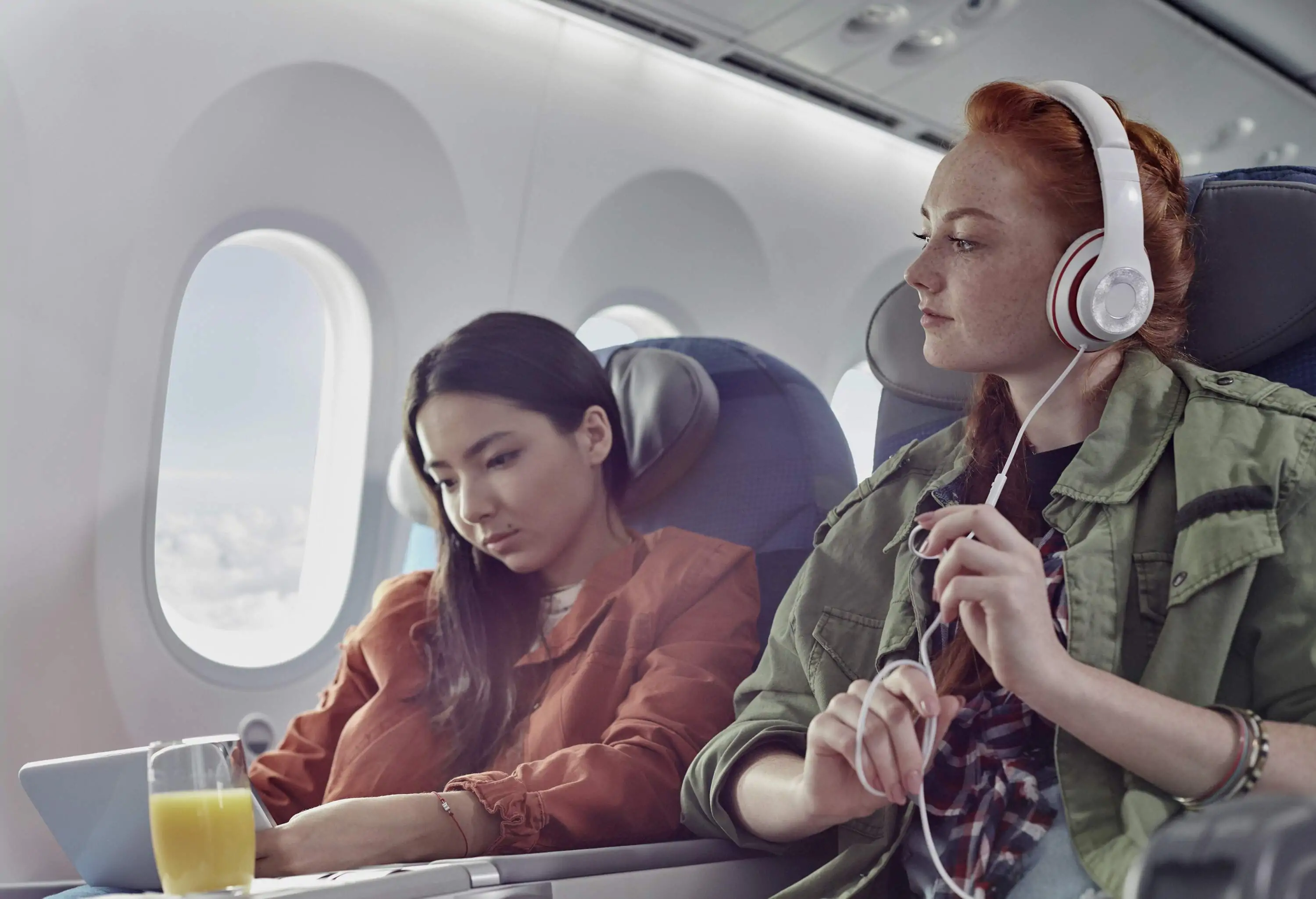For decades, musicians and writers have waxed poetic about the open road; Willie Nelson’s song “On the Road Again” and Jack Kerouac’s classic “On the Road” have extolled the virtues of hitting the road.
There’s nothing quite like a classic road trip – a dog-eared map impossible to re-fold correctly, the rush of wind flowing through rolled-down windows and endless possibilities for adventure.
Renting a car while traveling is a great way to go farther, see more and map your own adventure. But, before you hop in the car and set your sights on destinations unknown, we have some tips to help you plan the ultimate journey — wherever the road may take you!
PRE-TRIP: What to do before you leave
Use the buddy system. Travel with family or friends. Determine who will share the responsibilities of driving, who will navigate and who will plan the meals, rest stops and accommodations.
Decisions, decisions. Determine where you want to go and plot the farthest point. There are plenty of popular road trips through the United States, one of the most famous being the historic Route 66 from Chicago, Ill. to Los Angeles, Calif. (Check out our tips on how to take the perfect Route 66 road trip.) Regardless where you are heading, you should determine how long it will reasonably take to get there. Don’t plan for more than eight hours of driving per day. Once you know how long it will take, add an extra day or two in case of unforeseen delays.
Budget. Once you have chosen the destination, calculate the following costs to ensure you stay within budget:
- Gas mileage (AAA Fuel Cost Calculator helps to estimate costs).
- Meals and snacks
- Accommodations
- Sightseeing
- Souvenirs
Plan but don’t over plan. Traffic jams and unforeseen detours are inevitable. Luckily, apps like Waze update traffic and road conditions in real time; however, poor weather and traffic accidents can also put the brakes on your trip.
Schedule wisely. It’s no fun driving in rush hour traffic. Plan the start of your day before or after rush hour and plan to be finished driving before the evening rush.
Tune up the car. Be sure to check that your car is in tip-top shape. Consider a professional inspection if you aren’t handy. Consult this handy checklist to ensure sure your car is ready for the trip:
- Wiper blades
- Oil level
- Water level
- Windshield washer fluid level
- Belt and hose connections
- Tire pressure
- Turn signals
- Horn
- Headlights
- Spare tire – check air level and make sure treads are intact. Consider a full-size spare rather than a doughnut.
Consider renting a car. If you are going more than 1,000 miles or your car is older, you might consider renting a car, especially if you’re traveling abroad (Here are some tips for renting a care around the world). You won’t have to worry about the maintenance, and it may be equipped with GPS and roadside assistance.
Don’t get stranded. Consider signing up for a roadside assistance and/or rescue program.
Confirm cellular service. Double check with your cellular phone provider about countrywide coverage and roaming fees.
Don’t over pack. Stick to one bag per person so that all your gear fits in the trunk – leaving you plenty of room to stretch out in the car and stash treasures found along the way.
Get a gas card. Since you’re going to be stopping to buy gas often, consider signing up for a gas card to take advantage of discounts and deals.
Share your itinerary. Leave a copy of your itinerary with family or friends in case something happens.
GET PACKING: What to pack
Prevent having to constantly pull over by keeping these items at hand:
- Satellite radio. The days of jamming to a mix tape have been replaced with MP3 players, but you still might want to mix it up a bit. Getting static radio reception every 50 miles is a bummer. With satellite radio, you get to enjoy music and talk radio (almost) without interruption.
- Map it. It’s best to have an old-school paper road map or atlas as a backup should your phone or GPS die or break. If you are traveling a long way, buying an atlas is a better deal. Buy this year’s edition to ensure the most up-to-date information. Download the latest version of your favorite driving apps and ensure your GPS device is working.
- Sunglasses. The road ahead is likely bright so you may want to wear shades.
- Cash and coins for tolls. Tolls can pop up anywhere, so be sure to be prepared with small bills and quarters. Depending on where you are traveling, a transponder like E-ZPass may automate the process and save time in toll lines.
- Camera. Take photos. Lots of them – of the open road, quirky billboards, large roadside statues, cheap eats along the way and you and your friends. (If you do, be sure to share them with us on Instagram!)
- Cooler. Pack a hard-sided cooler with snacks and water. The following items are easy to pack and eat.
- Bottled water and juice. Freeze the water bottles and they can double as ice packs. Water is the best drink to pack because if it spills on you or the car, it’s easy to clean up.
- Cut fruit like grapes and apples and keep it in Tupperware or plastic baggies (this makes it easy to grab, eat and pass around the car)
- Raw veggies like carrots, celery and radishes.
- Bread and peanut butter or Nutella. Skip the jelly – it’s sticky and can slide off the bread easily.
- Hard cheeses like cheddar and mozzarella, which are solid and won’t smell.
- Individually wrapped snacks like granola bars, dried fruit, nuts and crackers.
- Avoid smelly foods like some flavored chips and jerky.
- Avoid perishable foods like sandwiches unless you have adequate ice, freezer packs or frozen water bottles to keep everything cold.
- Cleaning supplies. Keep the car and yourself clean with pre-moistened wipes for your hands, bleach wipes for quickly cleaning the interior of the car, paper towels or napkins and small plastic bags for trash.
- More essentials. Don’t forget these tiny but important items.
- Pocket Knife
- Cellphone car charger
- USB cigarette lighter adapter for charging electronics
- Paper maps and/or atlas
- License and registration
- Car insurance paperwork
- Medical insurance card
- Spare car key (put this in someone’s pocket in case you accidentally lock the keys in the car)
- OTC medications like aspirin and Pepto-Bismol
- Sunscreen
- Cash for places that don’t accept credit cards
- Portable video game player or DVD player for kids (and adults!)
Things to pack in the trunk:
- Spare tire
- Jumper cables
- Basic tools like a tire iron, lug wrench, jack, fire extinguisher and emergency triangles
- Survival kit with solar blanket, flashlight with fresh batteries and an extra set of batteries, bottled water and extra energy bars. If you are driving in the winter, also include an ice scraper, snow brush, hand warmers, gloves and hats.
- First-aid kit
- A few days’ supply of clothes and toiletries packed in soft-sided bags like backpacks and duffel bags, which take up less space than bulky hard-sided or wheelie luggage. Pack clothing that is comfy, lightweight and breathable. Dress in layers and be prepared for all types of weather.
- Rain gear
- Comfy shoes like sneakers and loafers. Don’t wear flip-flops or shoes that slip off easily when driving.
- Laundry hamper or organization crate to keep clothes, toys, beach gear and other travel goods organized.
HIT THE ROAD: Tips for driving the open road
Ensure smooth traveling by incorporating these driving tips:
- Use bypass routes to avoid construction.
- Avoid driving during rush hour which is typically between 7 a.m. and 9 a.m. and 4 p.m. and 6 p.m.
- Stop to take walks and naps. Plan stops in the afternoon and, if driving at night, in the middle of the night when drivers tend to feel most sleepy.
- Avoid fatigue or zoning out by channel surfing on the radio. Mix it up with music and talk radio. If you can, switch driving responsibilities with others in the car.
- Drive in the opposite direction of traffic. Avoid rush hour by driving into a city in the evening and drive out in the morning.
Save money on gas:
- Don’t over pack the car. Pack light.
- Obey the speed limit.
- Don’t rapidly accelerate or excessively brake.
- Keep the tire pressure accurate.
- Don’t drive on worn tires.
- Use a map to avoid getting lost.
Tips for reading a map or atlas:
- Study the legend (the group of icons located in a box on the map or at the front of the atlas) to decipher the maps. Use the atlas to map out scenic routes, avoid long-term construction projects and highlight rest areas.
- Two-digit interstates (I-95) are often the most direct routes through cities.
- Three-digit interstates (I-595) circle urban areas.
- Odd-numbered highways run north to south.
- Even-numbered highways run east-west.
ON THE ROAD: Expect the unexpected
Be prepared for hiccups along the way with these tips.
How to change a flat tire:
You hope it doesn’t happen, but it is inevitable that at some point, you might get a flat tire. Here’s how to keep calm and drive on.
- Pull over to a flat patch of road.
- Put on the parking break and hazard lights.
- Set out emergency triangles.
- Remove the hubcap.
- Use a lug wrench and loosen lug nuts counterclockwise. Don’t remove the lug nuts, as you want to keep the wheel attached.
- Use the jack to elevate the tire four inches off the road.
- Remove the lug nuts and pull off the tire.
- Slide on the spare.
- Screw on the lug nuts in a star pattern and tighten but not all the way.
- Lower the car so the tire is just touching the road.
- Fully tighten the lug nuts.
- Lower the car fully.
- Remove the jack.
- Give the lug nuts one last turn.
What to do if the car breaks down:
No matter how prepared you and your car are, sometimes breakdowns occur.
- Put on your hazard lights.
- If it is safe, place emergency triangles 25 feet behind the car or hang a cloth on the antenna or the side-view mirror.
- If it is safe, get everyone out and go behind a guardrail. If the road is heavily trafficked or not safe, stay in the car and keep your seat belt fastened.
- Call your roadside assistance company.
- Wait for help.
What to do if you are in a car accident:
Nothing will put the brakes on a road trip like an accident. Prevent an accident by stopping when you feel fatigued, not handling your phone while driving and staying alert at all times. If you do find yourself in a car accident, here is what to do.
- If it is safe, pull over to the side of the road and put on your hazard lights.
- If you can’t pull over, put on your hazard lights.
- Turn off the engine, shift into park or set the handbrake.
- Pause and look around before opening the car door.
- If the accident is minor, place emergency triangles 25 feet behind the car or hang a cloth on the antenna or the side-view mirror.
- Check on your passengers and the occupants of any other vehicle(s).
- Call 911 to get help for injured passengers and to have an accident report filed. Get the name and badge number of any responding officers.
- Whether you choose to call 911 or not, exchange the following information with the other driver(s):
- Driver and passenger names
- License plate numbers
- Insurance info
- Makes and models of all vehicles involved
- Contact info for any eyewitnesses
- Location of the accident
- Snap photos of the accident scene.
- File your insurance claim (some car insurance companies allow folks to call from the scene of the accident or upload details and photos via an app).
Combat carsickness:
Try to prevent motion sickness before it happens, but if it does, here is what to do:
- Avoid excessive alcohol.
- Don’t eat fatty, greasy or spicy foods.
- Don’t travel on an empty stomach.
- Avoid eating smelly foods in the car.
- If you are prone to motion sickness, sit in the front of the car
- If you are prone to motion sickness, avoid reading in the car.
- Keep your gaze fixed on the horizon or a fixed point.
- Look out the window and see the twists and turns in the road before they occur.
- Roll down the window.
- Consider taking over-the-counter medication like Dramamine.
- Wear motion sickness wristbands that apply pressure to trigger points on the wrist. If you don’t have the wristbands, place your thumb on the inner arm 1.5 inches above the crease of the wrist, according to WebMD.
- Eat or drink something with ginger.
BEAT BOREDOM: Ways to pass the time
Driving for hours and hours can get monotonous both for the driver and the passengers. Here are ways to cope.
If you are the driver:
- Listen to audio books, talk radio and music.
- Have a conversation with the folks in your car.
- Play non-distracting games.
If you are a passenger:
- Listen to audio books, talk radio and music
- Sleep
- Watch a DVD
- Have a conversation
- Read a magazine
- Play games
- Do puzzles
- Get a pen and paper and draw doodles, play tic-tac-toe or hangman
- Eat a snack
- Take photos
- Make a scrapbook along the way: Bring a scrapbook and glue stick. When you stop at each rest stop, get a postcard or brochures to add to the scrapbook.
- Look for quirky places to stop along the way. Then, stop and take photos for memories that will last a lifetime.
GAME ON: Classic road trip games
One of the best ways to beat boredom on the open road is to play games. Rather than playing cards or checkers whose pieces can go flying when traveling over a speed bump or making a quick turn, these interactive games are easy to play, free and fun.
Start a scavenger hunt: Have each passenger make a list of things to spot like grain silos, billboards and wildlife along the way. The first person to spot them all wins.
I Spy: One player looks around and chooses an object other players have to guess. He or she says, “I spy with my little eye something that begins with” and then inserts the first letter of the name of the object. Be sure you don’t choose something that is whizzing by the car.
License Plate Game: Try to find license plates from each of the 50 states. Easier variations of this game include spotting letters on license plates in alphabetical order – the first player that gets to Z wins – and then the second and third rounds include finding double letters in alphabetical order and then triples in alphabetical order.
20 Questions: As the name suggests, one player thinks of something and each person in the car takes turns asking a question to try to determine what the “thing” is. Questions like ‘Is it an animal, vegetable or mineral?’ and ‘Is it edible?’ are common beginner questions. If you reach the 20th question and are still stumped, everyone gets one final guess before the ‘thing’ is revealed.
‘Punch’ Buggy: Spot a Volkswagen Beetle and then ‘punch’ your seat mate to let them know. The person who spots the most wins. If you’re playing the game with children, you might just have them tap their seat mate or shout out that they have spotted the iconic car rather than punch each other.
Name That Tune: Karaoke-style, each player takes turns singing a song and the rest of the players have to guess it. Variations include hitting the ‘seek’ button on the radio and seeing who can guess the name of each song first.
Picnic Game: The first player begins with ‘I went on a picnic and I brought’ and then inserts an item that begins with the letter A. The next player repeats the sentence and includes what the player before said plus adds an item that begins with the letter B and so on. The key to this memory game is remembering and reciting all 26 items at the end.
ON THE ROAD: Make the most of the journey
Traveling to the destination is just as much as fun as reaching your final stop. Make the most of meals and miles along the way with these tips.
Where to eat:
Don’t just stick to fast-food joints and run-of-the-mill rest stops.
- Check the cooler. Stocking your cooler with snacks and water will reduce the number of pit stops and keep you from eating junk food 24/7. Re-stock as needed at rest stops and grocery stores along the way.
- Stick to a meal schedule. Getting overly hungry without a rest stop in sight for miles means you will be so ravenous by the time you find a pit stop and you’ll be more likely to pick the first fast-food joint that is open. Plan ahead so you can stop at roadside diners, mom and pop soda fountains and the like.
- Talk to strangers. Ask locals for advice on where and what to eat.
- Eat authentic. Skip chain fast-food restaurants and indulge in roadside restaurants, classic diners and soda fountains.
What to see and do:
Stop at quirky places along the way – oversized statues of food and figures and interesting scenery make for great photos.
- If it is safe to do so, take photos in front of signs at state lines announcing your arrival in new states.
- Stop for photo-ops at anything that would be considered a ‘tacky tourist’ hotspot.
- Ask the hotel staff for recommendations of what sights to see, from museums to theme parks to less famous but much-beloved local spots.




